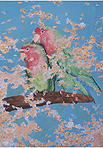|

The three artists presented
here each work with the idea of nature but take it a step further. Lisa
Jeanne Graf creates surreal landscapes drawn from fantasy; Marcella
Stasa uses found natural materials and reconfigures them into new
forms; and Carly Weaver manipulates paintings of fauna and flora by
gouging into the finished surface.
Each artist has a different style and approach to how they bring
forward the concepts they work with. What ties the three together is
the idea that nature and images of it have crossed a boundary by going
beyond representing beauty and provoking the audience to view nature in
a new light. The following statements from the artists give a
better idea of their individual approaches:
 Lisa
Jeanne Graf: Lisa
Jeanne Graf:
How nature protects itself, or is unable to, interests me a great deal.
I am inspired by nature’s will to survive, and adapt, and when it can,
thrive.
My landscapes are narrative works, with the plants, and animals as the
characters. These characters have lives of their own. I like to step
back and let them do what they will. Being allowed freedom of movement,
they not surprisingly often go awry.
I generally start with a doodle and
then bounce off of it until the work says it is done. A smaller number
of my works start with an idea, which I then illustrate. The seeds for
my works are nature, decorative design, architecture, life events, and
fantasy stories.
For the works on paper, I begin with a drawing, then add water based
media in layers, including markers, caran da’che crayons, water color,
gauche, china markers, and pencils. For the works on panel I paint with
egg tempera.
 Marcella
Anna Stasa: Marcella
Anna Stasa:
My work is made up primarily of found objects. I use decayed and rusted
materials in combination with things found in nature often including
animal bones. While some of these elements may seem morbid, I see a
great deal of beauty in them. Their broken state strikes me more as
eloquent than melancholy.
The impact these materials have on me is why I use them in my work.
They can be ugly, mysterious and all the while exceptionally lovely.
Combined in unlikely ways they have an ethereal sense, which can
disconcert and startle.
I see “Nature Gone Awry” as a reaction of the natural world to the
overwhelming impact of humans and also of my own reaction to the way in
which nature adapts to us. I use available natural materials in my work
to make a statement about both the current environmental condition of
the world and to focus on the beauty of it even in state of decay and
assault. I also see my work as a collaboration with the natural world,
where I reconfigure the materials at hand to develop new organic,
though unreal, forms. Nature goes awry in the fact of my manipulating
it.
 Carly Weaver: Carly Weaver:
Nature is a dominant theme in my paintings. My paintings have sampled
colors and textures from nature as flora and birds. Nature is an
inspiration for color, texture and theme, but is also used in process
and approach. I believe that every painting has its own life span and
is a living and breathing thing. Sometimes that means letting nature
run its course. The course might not be down the primrose path but a
path that obstructs, damages, and ruins the painting.
My palette, derived from red clay, dried earth, sky, and vegetation,
are then combined with textures. Chalky grays, gritty browns, with
gloss and matte finishes are combined with the honey colored surface of
birch wood, or the dark pulpy surface of the masonite undersurface. The
flux between all of the colors and textures mimic an organic order
found in nature.
However once I have gouged and mutilated the colorful renderings of my
subject matter, the painting takes on another entendre. Now the
painting is animated, fragile, and has a history or a life span. The
painting seems to have lived through something. Defacing the painting
gives an allusion to time or age, but more importantly challenges its
permanence. Like in nature things are never permanent.
While my work often has the romanticized notions of nature, there is
often a subversive connotation. Through defacing and attacking the
painting’s surface I am challenging the saccharine qualities and the
permanence of the image. The lovebirds are precious images when seen
through rose-colored glasses, but doesn’t prevent nature running amuck.

|
 Lisa
Jeanne Graf:
Lisa
Jeanne Graf: Marcella
Anna Stasa:
Marcella
Anna Stasa: Carly Weaver:
Carly Weaver: